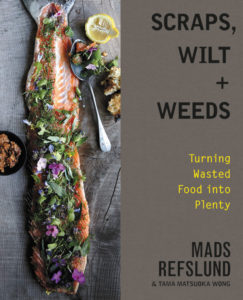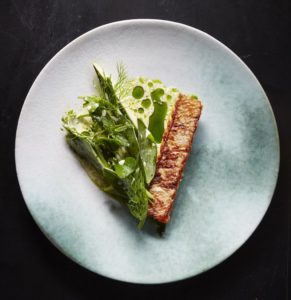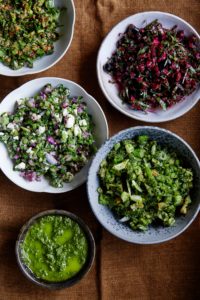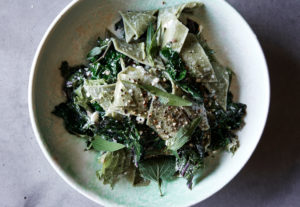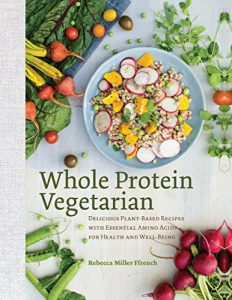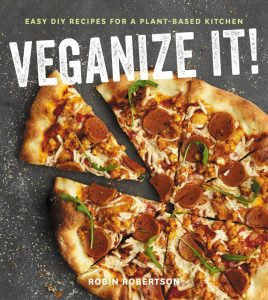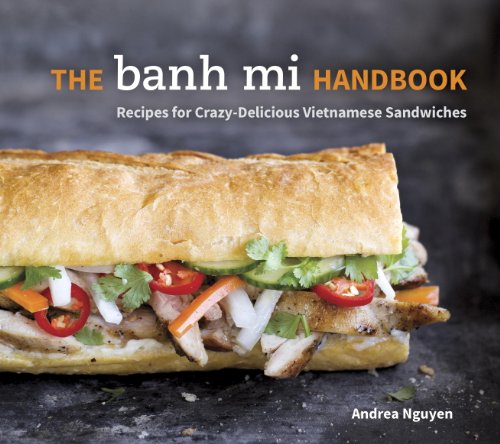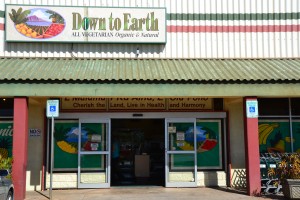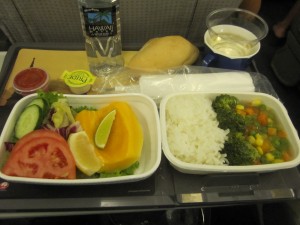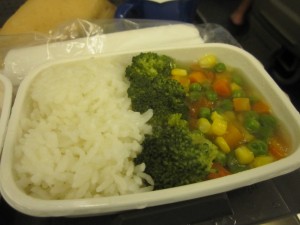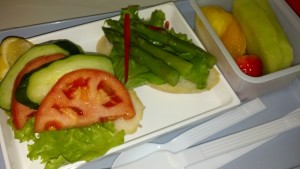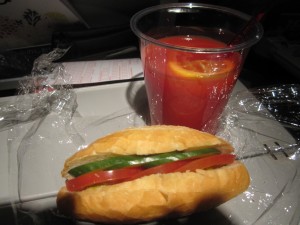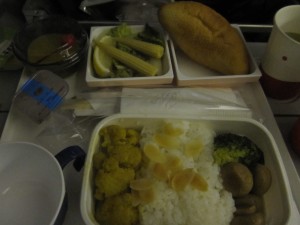Tag Archives: food
Glorious Food Waste
For decades, I have been gently chided, and occasionally mocked, for my kitchen frugality. A drawer filled with wilting produce sets off a visceral reaction leading to aggressive cooking. I don’t think it’s cheapness, as much as it’s a deep-seated concern about waste. Over the years, cooking teachers have denigrated the big, re-purposed Ziplock in my freezer chock full of plant scraps and leavings; apparently only pristine produce is good enough to make vegetable stock or fruit sauces. But still I persisted because, frankly, that just didn’t make any sense to me. And, besides, I just can’t empty that seemingly still good food into the trash or compost heap.
A short while ago, I stumbled on a wonderful “cookbook” Scraps, Wilt + Weeds written by Mads Refslund and Tama Matsuoka Wong. Refslund was a co-founder of world-famous Danish restaurant, Noma, and, shockingly, shares my visceral reaction to wilting, near-rotting produce! But he goes many steps beyond just making vegetable stock, dry-roasting just-past-prime produce, stewing less than perfect fruit into sauces and, of course, freezing very ripe bananas for breads and smoothies. Mads Refslund has elevated waste to haute cuisine.
The concepts are invigorating and inspirational – with stunning photographs that make near garbage extraordinarily beautiful. I use the word concept advisedly – to me the recipes are more conceptual than standard “multi-user-tested” ones. This is relatively new turf and the reader needs more guidance as to when, for instance, a tomato is near rot or just plain rotten. Even though I am a fairly accomplished home cook and long-time rescuer of wilted produce, I often had questions. For instance, a couple years ago I made carrot-top pesto from gorgeous, young CSA carrots and it was so bitter, it was inedible – why wasn’t his?
On the other hand, he encourages flexibility – use what you have (less, more or sub something else) rather than create more waste by buying to meet the specific recipe requirements. Other chapters focus on buying “ugly” produce, foraging for “weeds” and even using discarded fish parts. All told, it is a glorious paean to the minimization of waste and as I reluctantly released my non-renewable library copy, I concurrently added it to my Amazon list.
Mads Refslund has vindicated my kitchen frugality while he introduced others on whose shoulders he stands; those who have been long proselytizing waste reduction but who did not have his bully pulpit**. He has made reducing food waste sexy and chic. What a stunning, unbelievable accomplishment!! This is a book to own – a reference to stiffen our spines and alter our perceptions when we are about to sweep the leavings into the Waste King or the compost pot.
Why is this book so important? Every year, roughly 30% of all the food raised on the planet for human ingestion is literally wasted. If you just look at first world countries that number is even higher with the U.S. leading the pack at over 40%. According to the World Economic Forum, our global population is projected to reach 9.6 billion by 2050 – raising the leading question: how do we feed everybody? The United Nation’s FAO (Food & Agriculture Organization) posits that we already grow enough food, we just have to figure out how to save that 30-40% that we are currently wasting – which represents about 28% of the earth’s agricultural land. A whopping 25 percent of that waste is imperfect produce left in the fields to rot and 15% comes from tossed out, perfectly edible, food. (An additional, crucial, benefit would be to save the carbon footprint of all that wasted food –according to the EPA, landfills account for 34% of all U.S. methane emissions.)
** I am reading some of the author’s references and will share reviews and content in future posts.
Whole Protein Vegetarian – Delicious Plant-Based Recipes with Essential Amino Acids for Heath & Well-Being
By Rebecca Miller Ffrench. The Countryman Press 2016 $27.95 (Amazon $18.50/ Kindle $14)
Ms. Ffrench approaches recipes and daily menus from the very particular perspective of amino acids – in other words protein. There is a mantra in the plant-based world that it’s impossible not to get enough protein. That we actually consume too much protein and the invariable question from the canivores “how do you get your protein?” is mock-worthy.
But the author demonstrates that that might not be as true as we had assumed I was surprised when taking a hard look at the protein counts of some of the pulses and vegetables that we normally consume. If adequate protein is a concern, then this might be a useful reference.
It’s a handsome, hard covered book with bleed and full-page photos of about half the recipes. The recipes themselves are not particularly adventuresome or noteworthy – assuming you are steeped in current plant-based culinary arts. If you are not, then this is an excellent primer. I prepared a couple and they were fine family-dinner fare – but not guest material.
VEGANIZE IT! Easy DIY Recipes for a Plant-Based Kitchen
BY Robin Robertson – Houghton Mifflin Harcourt March 7, 2017. $25. Amazon $14.92/ Kindle $12.99
Another really good book from one of the top vegan cookbook authors. Robin Robertson’s books are classics and I have most of them. So I had high expectations for this one. It’s a beautifully designed book with a stiff fold-in cover for marking your place and lots of full-page photos and chapter intros that sometimes bleed across a double-page spread.
The chapters are similar to those of an omnivore cook book – with a twist. Plant-Based Meats, Vegan Charcuterie, Instead of Seafood, Dairy-Free and Egg-Free, Too…. all very enticing.
Since 2010, I’ve been turning to Steen & Newman’s “The Complete Guide to Vegan Food Substitutions: Veganize It! Foolproof Methods for Transforming Any Dish into A Delicious New Vegan Favorite.” And collecting recipes from chef-written cookbooks, blogs and the www. There have been so many advances in plant-based cooking in the past six years that I thought Roberstson might, essentially, be providing an updated, cutting edge version of “The Complete Guide…”. And in some ways she has. But I was hoping for some break-through ideas instead of riffs on existing chef or blogger-developed veggie cuisine. Or at least a compilation of those best of the best ideas. But I misunderstood the intention – which might have had something to do with the similarity of the titles…..
Instead, the book provides “clean” vegan recipes for lots of basics like sour cream cream cheese, cheesy sauces, ricotta, hollandaise, feta, butter!, gravy plus many, many more. Beyond basics are burgers, pulled pork, fish ‘n chips, sausages, meatballs, sea scallops, five bacon recipes, and more. Many of these products are available in the supermarket freezer or refrigerator case but made with a laundry list of additives and other unpronounceable ingredients. So this is why I add the word “clean.” Ms. Robertson first chapter includes home-made versions of pantry items (many of which are not vegan in their store-bought versions). Each chapter also includes more involved recipes that use a few of the basics made from the included recipes or, if time is short, from store-bought versions.
I started my review by preparing a couple of the recipes. First was Creamy Ranch Dressing that starts with 1 cup of mayo – it had good flavor but the mayonnaise was too prominent so I cut it with a little almond milk that also made it more pourable. The second one was Cheddary Sauce which is pictured below (these are my photos, not from the book). This was a tasty cream sauce and it worked well over a steamed veggie and quinoa bowl, but it didn’t taste anything like cheese, especially cheddar, which the name implied. I made it in a Vita Mix so just letting it blend a little longer heated it up – once the cashews had been soaked, it was quick and easy despite a lengthy list of ingredients. I will make it again – perhaps amping up the seasonings and playing with the liquor choices. Next up are the five bacon recipes and the pulled pork.
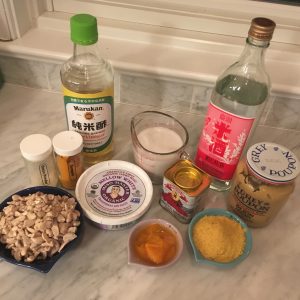
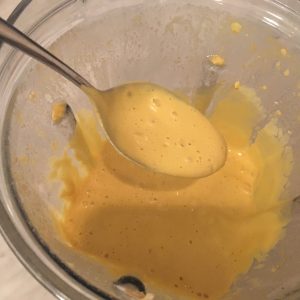
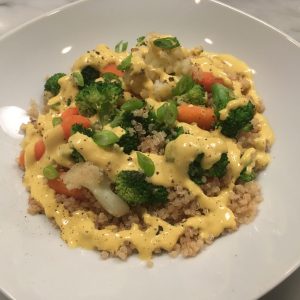
A couple nitpiks: Recipes labeled with cheesy names have to taste cheesy – nooch just doesn’t taste cheesy to me. And there isn’t any nutritional info – I’d like to know the calorie count and the percentage from fat – is it a 30-cal tablespoon or a 125 cal one? Also while the cashew craze has been well addressed, alternatives would be appreciated (since cashews are high-FODMAP) and a little more on aquafaba would also be helpful and suggestions for those among us who choose oil-free.
Bottom line – this book is a keeper. There are enough interesting concepts in here to encourage experimentation. It is not haute cuisine, but it is reliable, tasty, clean vegan. And that’s worth a lot.
Good Clean Food Shopping Smart to Avoid GMOs, rBGH and Products that may cause Cancer and other Diseases
By Samuel Epstein, MD and Beth Leibson – Skyhorse Publishing 2013. $24.95/ Amazon $16.99, $6.50 used
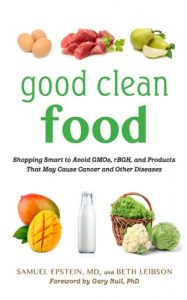
Dr. Epstein is a voice we should hear. His long and deep expertise on the avoidable causes of cancer has been shared in twenty books and 270 peer-reviewed articles. He is professor emeritus of environmental and occupational medicine at the University of Illinois School of Public Health and chair of the Cancer Prevention Coalition. He has also served as president of the Rachel Carson Council and other industry organizations. Co-author Beth Leibson knowledgeably unpacks this far-ranging erudition to make it accessible and understandable to the layperson.
This is a short read outlining important concepts that are clearly described – the main foci are:
Milk – the US permits the injection of the genetically-engineered growth hormone (rBGH – named by Monsanto Posilac) into dairy cows which causes elevated concentrations of IGF-1 (Insulin-like Growth Factor). The upside is that it increases milk production by 11-15%, the downside for the cow is that they get sick, for instance 25% get mastitis which adds more pus to the milk and which also requires antibiotics. About 20% of dairy farms in the US inject their herds with rBGH which creates IGF-1 but, since labeling is not required, consumers have no idea. The downside for the consumer, in addition to the antibiotic load, is that IGF-1, which is not destroyed by pasteurization, encourages cells to grow – in children it’s usually bones and organs, in adults it can be cancer cells. So, if you choose to continue to use dairy products, buy only organic from grass-fed herds. BTW: The EU and Canada outlawed rBCH and IGF-1 in the 90s. Better yet – plant milk.
Beef – Starting in the ‘50s, US cattle have been injected and/or fed a wide variety of sex hormones and other growth drugs. Today that cocktail, injected into 90% of all US cattle, contains natural estradiol, testosterone, and progesterone plus synthetic hormones zeranol, trenbolone, and melengesterol – all designed to add quick weight and roughly $80 additional profit per animal. The EU outlawed this practice in 1989. Industrial farmed meat cows are also fed prophylactic antibiotics which has contributed to the creation of superbugs that jump to humans and are resistant to most if not all antibiotics. Other beef topics include nitrates (and the link between hot dogs and pediatric brain cancer), radiation, the significant advantages of grass-fed beef and, again, the need for labeling.
Produce – The Dirty Dozen/Clean Fifteen – The Environmental Working Groups master list of the dozen most likely fruits and vegetables, when conventionally grown, to be drenched with pesticide – add kale and collards to the EWG list. The Clean Fifteen lists those least likely to be tainted. The authors also suggest buying “American” since imported produce usually contains higher percentages of pesticides. This chapter then details the negative effects of these insecticides and herbicides, many of which contain Organophosphates, which has been shown to block acetylcholinesterase that stops nerve cells from firing. The demonstrated effects include increased incidences of ADHD, autism, reduced memory and lowered IQ. The answer is organically grown produce.
Corn and Soybeans & GMOs – These are the two most prolific foods on the planet; corn, for instance, provides over 20% of all human nutrition – but both are largely used for animal feed. Both can be cultivated as vegetables or as oil or as…. The broad-spectrum herbicide Roundup, a ramped up version of Glyphosate (which is a type of organophosphate), was developed by Monsanto to increase field yields. Monsanto also developed many Roundup-ready, patented crop seeds that can tolerate the pesticide. Initially Roundup works, but then, over time, the weeds become resistance and the farmers find it necessary to increase the quantity of Roundup creating more dangerous conditions for farmers and consumers. Glyphosate-resistant alternatives exist but share the same problems – they kill off amphibians as well as pests and weeds and they contain an inert ingredient (a surfactant) to help the chemicals penetrate the plants which has shown to be harmful to humans. A newcomer is Bt corn (Bacillus thuringiensis), a plant that exudes its own pesticide which is also dangerous to other living things, like butterflies and humans. The chapter concludes with a review of the politics as well as alternatives – especially non-GMO organic.
Chicken & Eggs – Conventionally raised chickens (and eggs) are fed a wide range of ingredients to encourage speedy growth including prophylactic antibiotics – which pass to humans creating similar problems to those of beef. At first brush, the answer seems to be organic. In order to be labeled organic, broilers and egg-laying hens alike, must be fed organic feed without antibiotics (except for illness), hormones or pesticides and they must have access to the outdoors. An organic egg comes from an organic laying hen. But beware the various levels of “organic” – large-scale industrial and some family-size organic egg farms may offer an open door with an impenetrable maze to access it so there is no “scratching in the dirt.” The key descriptor seems to be “pasture-based” or “free-range” organic where mobile housing moves frequently to fresh fields and the birds are outdoors as often as inside. All of this applies to “broilers” as well.
Avoiding GMOs – This gets harder every day; again look for the word “organic” otherwise almost any, for instance, soybean or soybean derivative will likely be from GMO plants– but at least know the legal definitions: “100% organic” means just that. “Organic” means 95% of ingredients are. “Made form Organic Ingredients” 70-94% is organic. The word “organic” on the ingredient panel only means that less than 70% is organic. An on fruits and vegetables – look for a label with a 5-digit number beginning with 9 – that’s organic. Beginning with an 8 means GMO (but that’s rarely labeled). Four digits beginning with 3 or 4 means conventional.
The remainder of the book discusses detoxification and future trends like Budget organics – private labels, Farmers’ markets, CSAs Buying clubs, Food Co-ops. And trends among various ethnic groups and around the world – all of which are well worth reading. Finally check out the organic industry watch dog: Cornucopia Institute www.cornucopia.org.
The Banh Mi Handbook – Recipes for Crazy-Delicious Vietnamese Sandwiches
by Andrea Nguyen. Ten Speed Press 2014. $16.99 (Amazon $11.43, or $4.99 Kindle)
Banh Mi sandwiches have been the subject of so many articles and restaurant reviews that they have certainly captured my imagination and my salivary glands. But they are so meat-centric that I just couldn’t figure out how to replicate this described deliciousness within the confines of even a flexible plant-based diet. Nguyen’s small, hard-cover book helped me figure that out. This is by no means a vegetable-forward book; the bulk of the recipe chapters cover all of the main meat, poultry and seafood categories. But, there is a chapter on vegetarian fillings, two on breads and other “holders,” and, probably most important, one on mayonnaise, sauces and pickles which form the flavor profile that makes Banh Mi sandwiches so addictive. So you might find it worth the investment in a Kindle version for the Baked Maggi Tofu, Edamame Pate or the four other vegan fillings or for the flavorings of her meat pates that could be reinterpreted in a mushroom or bean pate.
Maui – On the Road to Hana
We decided to drive the supposedly totally off-the-beaten-track but spectacular Road to Hana along Maui’s northeast coast. The warnings were universal – take lots of water and food, gas up the car – there’s nothing along the whole route – perhaps 55+/-miles with 58 bridges (many one-lane wide) and over 250 serious curves – plus untold vistas and one-car-wide pull-offs. So the estimate is about 4 hours to get to Hana and as long to get back – with stops at the top five attractions. The warnings also advised against taking the “dotted line” road back to Wailea that would complete the circuit – so we had to come back the same way or void our car rental agreement if we were found out…
Consequently, we wasted a good hour getting prepared for this major odyssey in our little fire-engine red convertible – about half the rentals in Maui are convertibles and most of them were headed to Hana at the same time we were. Many of the warnings proved over the top or just plain wrong. Except one – there are 58 bridges, most one-lane wide – and over 250 curves – so no wine and beer on this trip. But were were happy that we had provisioned at Down to Earth – an organic, all natural market just south of the Hana Road that makes delicious plant-based sandwiches ($7.99 each) – subs and wraps – and offers a wide range of “healthy” chips, drinks and well-priced water. downtoearth.org.
The drive was made far more interesting because we rented a GyPSy GPS program that provided fascinating commentary on what we were passing or stopped at – along with a lot of history and anecdotes during the long stretches of gorgeous scenery.
Our experience was that there are services along the way – but maybe not year round – so check. There’s a small cluster of shops and snack bars, tiny family-run roadside stands – some offering fruit, vegs, burgers or pastries. And there is a gas station in Hana along with some basic dining options, an “historic General Store” that has seen better days, and a resort. FYI: several people told us later that the “dotted line road,” which would have made this an even more interesting drive, is just fine at this time of year and we should have taken it.
For images of the Road to Hana, please see this link to Pinterest.
Vegan on Japan Airlines
So many airlines have seriously disappointed with the quality of their long-haul meal offerings for “strict” vegetarians but I had high hopes for JAL. After all, dairy isn’t even a real player in Japanese cuisine – so we are just dealing with meat/fish/egg-free. Considering the possible options – veg sushi, soy anything, especially edamame, rice, seaweed, amazing vegetables plus the whole range of Buddhist vegetarianism,this was going to be a slam dunk. Wrong! On two long legs (12 hours originating in Honolulu and 8 hours Tokyo to Singapore ), the food was sub-standard JFK catering quality. When I looked at the food my seat mate (husband) was served, I was even more disappointed. (Even though he, too, eats a whole-foods, plant-based diet, he long ago gave up airline “special meals” and just picks and chooses from whatever they are serving – sometimes he is very hungry.)
The Hawaii to Japan leg, offered the better of the two. JAL served a main VGML and a breakfast snack. A beautiful hunk of papaya on a small bed of lettuces with two cucumber slices and two tomato slices was accompanied by a barely edible “entree” – white rice, overcooked broccoli, and frozen mixed carrots, peas and corn – no sauces. “Breakfast” was a fresh salad – three asparagus spears, two tomato slices, two cucumber slices and a few pieces of fresh fruit.
On the Tokyo-Singapore leg JAL served a snack that was ridiculous (a tiny roll with two very thin cucumber slices and two very thin tomato pieces- no sauce or condiment) and a main meal just before landing at 6am that was a slightly better dinner. White rice sprinkled with almonds flanked by decent cauliflower overcooked broccoli and button mushrooms accompanied by a salad of a few lettuce leaves and two baby corn ears. Considering that these were sourced in Tokyo, the quality was even sadder. The primary meal for the rest of the plane was a delicious “bento box” with a layer of sticky rice topped by a layer of toasted nori with a smoky roasted salmon filet. It would have been so easy to “veganize” this…..
Tokyo Airport was a bit more interesting with some good veg options.
Plant-based Food That Travels II – Condo or Galley
Here are some more thoughts on packing light-weight, useful foods that give you a head-start on provisioning a condo kitchen or boat galley:
A ready-to-pack plastic bag – keep one at the ready and drop stuff in as you find it – because it’s so easy to forget what you bought in the craziness of packing.
Small Condiment Packets: We collect little plastic packages of wasabi, hot mustard, soy sauce, sweet & sour,
that come with take-out or are available on salad bars. Sometimes just one packet is all you need to kick up a dish.
Assorted spices packed into either in a multi-compartment spice containter or in little 4 oz plastic bags or vials – an italian
mix, herbes de provence, cumin, salt substitute, and a curry mix would be a good start. We try to keep on hand most of the spice mixes that Mark Bittman details in his How to Cook Everything Vegetarian book so it’s easy to pack up a vial or small package. BTW – more than half the book is vegan or describes vegan substitutes – it’s great!!
Tempeh – frozen – if the trip isn’t too far, the packages will still have a chill on them when you arrive and yo may not find it so easy to track that down in a resort community.
More ideas later….
Plant-based Food That Travels – Condo Kitchen or Boat Galley
With new weight limits these days, trying to pack a base supply of food for a Charter Boat or Condo Vacation can be problematic. We’ve all learned that we need at least some starter foods while we check out the local purveyors – food we can trust and count on.
I started researching easy-to prepare meals that work when there is a kitchen or a galley (and that don’t weigh too much) – and even ones that could work in a hotel room with a coffee maker that delivers hot water.
Here’s the first installment:
Thai Kitchen products that are Vegan, lightweight and pretty tasty:
Rice Noodle Meal Kits: Thai Peanut, Lemongrass & Chili, Toasted Sesame
Noodle Carts: Pad Thai, Thai Peanut, Roasted Garlic, Toasted Sesame
Take Out Boxes: Thai Peanut and Tangy Sweet & Sour
Jasmine rice Mixes: Roasted Garlic & Chili and Jasmine Rice
Oatmeal Packets
Salt & Pepper grinders – either the disposable ones or a single unit
that grinds both. Chances are it will be humid and a salt grinder will be
welcome.
Vegetable broth cubes or tubes.
Soy milk – Small aspetic packages
Tofu – Aseptic packages of Extra firm, firm and silken
Wild Rice – all cooked – from Trader Joe’s – instant side dish, entree base
or wonderful with oranges, scallions and a citrus dressing!
10 Food Strategies for Plane Trips
We fly a lot – and we’ve learned that even in the chaos of last minute packing, it’s critical to take the time to prep a food carry on.
Of course, a few days before a flight, we always log on to the airline website to choose the best possible “Special Meal” option — assuming that a meal is being served it all. We also always consider it a bonus if we get something edible – and that is usually on international carriers like Emirates or China Air where plant-based dishes are part of the native cuisine. On domestic flights, food is usually a snack, there’s no way to request anything special and, surprisingly, it’s almost never plant-based – except for the occasional carrot and celery sticks with two cherry tomatoes and diary dip that you can buy.
So we’ve learned:
1. Keep a box of those little 1.5 oz size hummus containers from Costco in the fridge (a dozen to a box for a little more than what they sell one for with pretzel crisps at
airport kiosks). You can even buy a big bag of those great pretzel crisps and plastic bag them. I take enough for a round trip and store them in the mini-bar at the hotel.
2. Make big roll-up sandwiches spread with veggie dips and stuffed with other goodies that won’t spoil. (recipes to follow). Cut them in fourths on the diagonal and bag each quarter in a sandwich baggie.
3. Pack a quart size bag of celery sticks, broccoli florettes, cauliflower stems, jicama sticks, skinny asparagus, grape tomatoes, and raw (or par boiled) carrot sticks for dipping in the hummus or just munching.
4. Throw in fruit – apples, pears, grapes (especially grapes), bananas (be careful where you put them, they can really make a mess).
5. Nuts! I always have a bag of almonds in my purse. Also, keep a trail, granola or other snack mix on hand so it’s easy to bag a few handfuls. Also toss in a half dozen good granola bars.
6. Find a small insulated pack and keep it handy for loading up. We have a tall, flat bag with a velcro top that was a give-away at a convention. It takes up a lot less room – packed and empty – then the cube-shaped ones with handles. One of these makes it easier to manage the food in a cramped economy seat and keeps the food from oozing onto your books or Kindle.
7. Carry tea bags. I’ve been drinking green tea for way more than a decade so I got in the habit of always having some tea bags in my purse – since in the early days restaurants didn’t know what it was. A flight attendant will usually be happy to provide hot water – and airlines that serve tea as a standard alternative to coffee make it in advance with not such great quality black tea.
8. If you have access to an airport club, they are generally more in tune with their customers than the airline catering services. We have found the little hummus containers, small peanut butter cups, pitas, fresh fruit, fruit “cocktail,” quality snack mixes, pretzels – and they don’t seem to mind if you pocket a few items for the trip
9. Troll the food kiosks on the gate-side of security for unexpected finds – the offerings are getting better and better (that’s where we first discovered the hummus cups and pretzel crisps). But the prices are also getting higher and higher. So this is a good place for inspiration if not shopping.
10. Bring enough to share. If you are traveling with a friend or business colleague, be sure you have enough for both of you – an offer to share will almost always be gratefully accepted (even by meagens*).
*Our grown son, the only one of us not eating a plant-based diet, has dubbed himself – and others of his ilk – a “meagen.”
